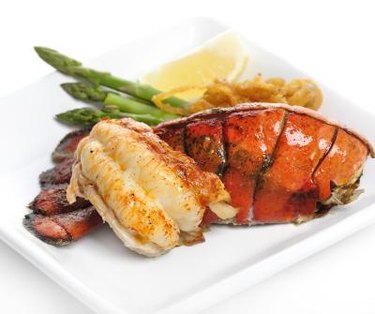
For those who love seafood, frozen lobster tails are a great convenience. They don't take up a lot of space in the freezer, they keep well for several months and they're a quick way to make your meals more memorable. The only catch, as with any other frozen food, is thawing it in a way that reflects food safety standards.
Time and Temperature
Video of the Day
Time and temperature are two highly important factors in food safety that are crucial when thawing foods. Hazardous bacteria, or pathogens, are inactive at temperatures below 40 degrees Fahrenheit. As the temperature rises, they become active and begin to multiply. Eventually they reach a large enough population to form what's called an "infective dose" -- enough bacteria to make someone sick. The goal of thawing foods safely is to defrost the food all the way through without leaving the surface areas at a dangerous temperature any longer than necessary.
Video of the Day
Correct Procedure
Seal your lobster tail in a heavy-duty zipper-seal bag. Place the bag in a clean bowl or plastic tub, and set it under the cold water tap in your sink. Run the water until it is as cold as it gets, and then turn it down to a slow trickle. The bowl will fill up and begin to spill over. As your tap water circulates in the bowl, it brings the lobster tail up to the temperature of the surrounding water. That should take less than two hours, which is the safety limit for this thawing method.
Cooking
Lobster and other forms of shellfish are highly perishable. Only use this method to thaw a lobster tail if you're going to cook it on the same day, and preferably right after you've thawed it. If it's not practical for you to cook the tail right away, take it out of the cold water while it's still slightly frozen and refrigerate it until you're ready to begin cooking. This helps minimize any risk of food-borne illness. A thawed lobster tail can be prepared in the same way as a fresh one with only a minimal difference in flavor and texture.
Alternative Methods
Of course, running water is not the only method for defrosting a frozen lobster tail. The best and safest method is to thaw the tail slowly in your refrigerator, where it will remain at a safe temperature throughout the process. If time is especially pressing, you can thaw a lobster tail in the microwave. This isn't your best option, because it tends to toughen the lobster. Another alternative is to cook your lobster tail from frozen, which quickly raises its temperature past the bacterial "danger zone" of 40 to 140 degrees Fahrenheit.
- National Center for Home Food Preservation: Thawing and Preparing Foods for Serving; Elizabeth L. Andress, Ph.D., et al.; 2006
- USDA Food Safety and Inspection Service: The Big Thaw — Safe Defrosting Methods — for Consumers
- U.S. Food and Drug Administration: Bad Bug Book -- Foodborne Pathogenic Microorganisms and Natural Toxins Handbook Infective Dose Information